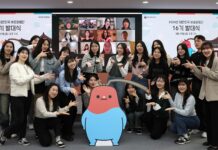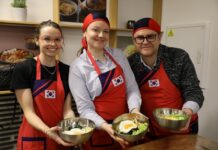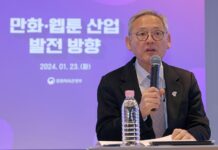| To gauge the direction of cooperation between Korea and the world, Korea.net is running a series of interviews with ambassadors to Korea. The second installment of this series features Danish Ambassador to Korea Thomas Lehmann, who speaks on the past, present and future of ties as this year marks the 60th anniversary of bilateral relations. |
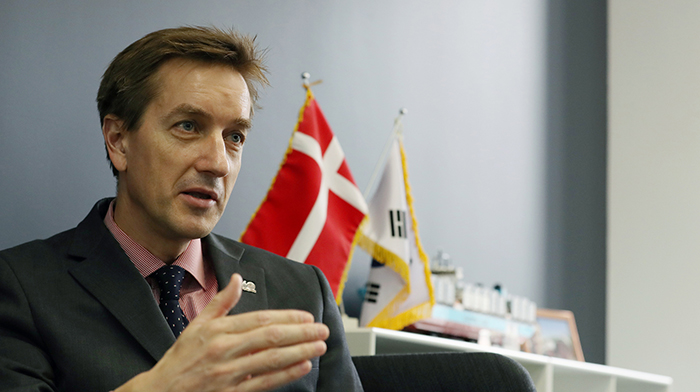
Danish Ambassador to Korea Thomas Lehmann on March 14 at the Danish Embassy in Jung-gu District, Seoul, explains the history of friendship and relations between Korea and Denmark.
By Yoon Sojung and Kim Minji
Photos = Jeon Han
Video = Kim Sunjoo
Seoul | March 14, 2019
“Although Korea and Denmark mark the 60th anniversary of diplomatic relations this year, our relationship actually goes back more than 100 years.”
Danish Ambassador to Korea Thomas Lehmann, in a March 14 interview with Korea.net at the Danish Embassy in Seoul, said bilateral ties stretch as far back as 1902, when both nations signed the Friendship, Trade and Sea Trade Treaty.
With Seoul and Copenhagen marking the 60th anniversary of diplomatic ties this year, both governments are holding events under the “Year of Culture 2019” program to commemorate the milestone.
“Culture is the best thing to help make the peoples of both countries better understand each other,” Lehmann said.
“I think this cultural year and the 60th anniversary represent a unique opportunity for the peoples of both countries to achieve better understanding of each other’s culture.”
In economic cooperation, the ambassador picked renewable energy and industries related to the Fourth Industrial Revolution as core sectors for bilateral collaboration.
The following are excerpts from the interview.
– This year marks the 60th anniversary of diplomatic relations between Korea and Denmark. What is your impression of this milestone as the Danish ambassador to Korea?
Relations between Korea and Denmark actually go back much further. They go back more than 100 years to 1902, when both sides concluded the Friendship, Trade and Sea Trade Treaty. Since then, the two nations have successfully worked together as partners thanks to similarities such as both being small countries, open economies, trade minded and very innovative, and having strong populations and focus on education. Many of these factors have brought us together.
This is what makes the celebration for the 60th anniversary of bilateral ties so special. The best way to celebrate is through culture. So we dedicate this year as a year of culture with activities in both countries.
– Korea and Denmark will each host a variety of events throughout the year to mark this diplomatic milestone. How has the celebration been overall and what must-see events are in Korea?
Both countries will host a variety of events throughout the year, ranging from those on fine arts, design and craft arts and music concerts such as jazz and orchestra, all aiming at boosting understanding between the peoples of the two countries. To promote the year-long program of cultural events, each side has named a well-known figure — Kang Sue-jin, artistic director of Korean National Ballet, and Danish Crown Princess Mary.
Key events in Korea include a modern art exhibition in April and one on contemporary art in May and the Busan International Film Festival, Jarasum Jazz Festival and Cheongju Craft Biennale in autumn. We’re also preparing for a closing event to end the celebration with an excellent finale at the end of this year.
We want to show the best of what we have and the modern side of Danish culture because these cultural exchanges will bring people together. And hopefully one day, this will also lead to direct flights between Seoul and Copenhagen, which will further increase our exchanges and contacts.
– Since your first interview with Korea.net last year, three inter-Korean summits and two North Korea-U.S. summits have taken place. How does Denmark see the overall peace process on the Korean Peninsula?
First of all, the rest of the international community and we really welcome and look at this in a very positive way. The diplomatic process President Moon Jae-in has spearheaded and is engaged in deserves all kinds of respect.
We fully support that, we are hopeful, and we want to see peace and stability on the Korean Peninsula because it’s so important not only to this region but also the international community.
We hope the diplomatic process leads to complete, verifiable and irreversible denuclearization that can then be an important step forward to prosperity for all people on the Korean Peninsula, because that is what they deserve.
– When President Moon Jae-in visited Denmark in October last year, he emphasized bilateral cooperation especially in renewable energy, green growth and other eco-friendly areas. Have tangible results or progress been seen in these sectors?
We were very honored and proud to have President Moon make an official visit to Denmark in conjunction with the P4G (Partnering for Green Growth and Global Goals 2030) summit there.
We are very supportive and positive about the ambitions laid out by the Korean government to go toward more renewable energy in Korea under the so-called 3020 plan, which targets 20 percent of energy coming from renewable sources by 2030.
If you increase the use of renewable energy and reduce the number of core power plants, you can also find a breakthrough to tackle the issue of fine dust, the main cause of air pollution Korea has been recently experiencing. You can still achieve economic growth while boosting energy efficiency and reducing fossil fuels.
Denmark has a lot of experience (in this area) and we’ve succeeded in it. So can Korea. Energy transition and renewable energy sectors will also lead to job creation and new growth engines.
To solve the fine dust issue, we need international cooperation and partnerships with other countries because (the effects of) climate change cannot be handled by one country alone. That’s why it’s important for Denmark, Korea and many other countries to join hands in promoting an agenda for reducing air pollution and increasing renewable energy sources.
This is what we do in the U.N. and in the P4G platform. This is what we do at wonderful institutions like the Global Green Growth Institute, which is headquartered in Korea and has Denmark as a founding member.
In Denmark, we’ve been moving toward becoming 100-percent renewable (energy) by 2050. By 2050, Denmark will be independent from fossil fuels. But we won’t be able to do it alone. We need partnerships (and) technology that can assist us in that drive, and Korea has very important technologies.
– What sectors are both countries showing the most active cooperation in and what are promising fields for collaboration?
Apart from energy and technology, I would say medicine, life science and food. Both countries have aging populations. Cooperation in pharmaceuticals and medical equipment and institutions can bring both business opportunities and growth engines.
Food is also a promising area. People are showing stronger interest in safe and healthy food these days. In Denmark, we have a strong trend of organic food. Considering the growing demand for quality organic food, food is another area for future cooperation.
– What Danish food, culture or tourist attractions would you recommend to Koreans? And what charms of Korea would you advise Danes to experience?
If you visit Denmark, Copenhagen is a must. In Copenhagen, use a bicycle, make sure you don’t walk as a pedestrian. Bicycles are the main (mode of) transport in the city, which has more bikes than people. There, you can see the famous Little Mermaid statue, and can also find various cultural events taking place in museums and galleries (for) the Korea-Denmark Cultural Year. For food, I would (recommend) open sandwiches and rye bread, both of which are healthy and tasty.
For Danes, I would recommend that they visit Seoul first. This is one of the world’s most vibrant and dynamic places yet has wonderful tradition. At Yeouido Hangang River Park, you can also find a smaller version of the Little Mermaid statue, which is nicknamed the “Little Mermaid’s sister.” For those who want to understand Korea deeper, I would recommend a visit to the Demilitarized Zone (DMZ) to better understand the World War II, the Korean War and the division of the Korean Peninsula. At the DMZ, you’ll get a different feeling if you see the North Korean side from there.
– You assumed your ambassadorial post in 2014. What do you like best about life here?
Korea has been a fantastic learning experience for me and my family. This is the first country for me as an ambassador. My daughter Sofie was born here. Especially last year, the spirit of the “Peace Olympics” of the PyeongChang 2018 Olympic Winter Games was unforgettable, and I saw moments of peace spawning on the Korean Peninsula. I have been also preparing to host the (60th anniversary) celebratory events to mark the diplomatic milestone, so I’m very grateful for everything.
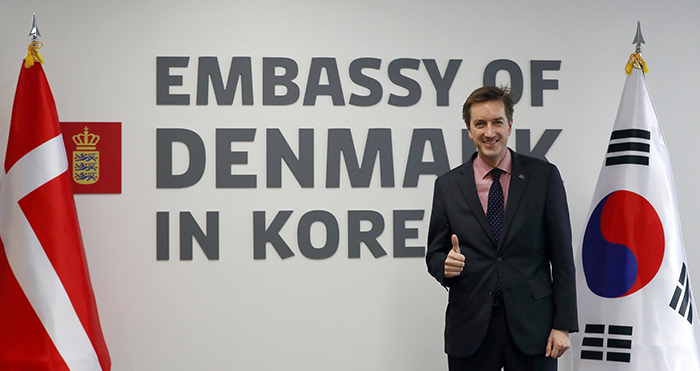
Danish Ambassador to Korea Thomas Lehmann on March 14 stresses the significance of the Year of Culture 2019 between Seoul and Copenhagen, saying, “Understanding the culture of a country is the way to look ahead to the future relationship between both countries.”




